 W
WThe invention of the camera in the early 19th century led to an array of lens designs intended for photography. The problems of photographic lens design, creating a lens for a task that would cover a large, flat image plane, were well known even before the invention of photography due to the development of lenses to work with the focal plane of the camera obscura.
 W
WThe Rodenstock Imagon is an achromat doublet photographic lens design uncorrected for spherical aberration used together with diffusion discs called sieve aperture. The lens is one of the classic professional soft-focus "portrait lenses".
 W
WAn anastigmat or anastigmatic lens is a photographic lens completely corrected for the three main optical aberrations: spherical aberration, coma, and astigmatism. Early lenses often included the word Anastigmat in their name to advertise this new feature. The first Anastigmat was designed by Paul Rudolph for the Carl Zeiss AG in 1890.
 W
WThe Angénieux retrofocus photographic lens is a wide-angle lens design that uses an inverted telephoto configuration. The popularity of this lens design made the name retrofocus synonymous with this type of lens. The Angénieux retrofocus for still cameras was introduced in France in 1950 by Pierre Angénieux.
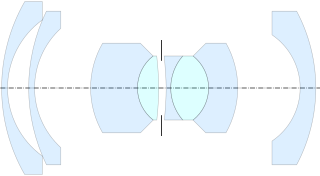 W
WBiogon is the brand name of Carl Zeiss for a series of photographic camera lenses, first introduced in 1934. Biogons are typically wide-angle lenses.
 W
WBiogon is the brand name of Carl Zeiss for a series of photographic camera lenses, first introduced in 1934. Biogons are typically wide-angle lenses.
 W
WA catadioptric optical system is one where refraction and reflection are combined in an optical system, usually via lenses (dioptrics) and curved mirrors (catoptrics). Catadioptric combinations are used in focusing systems such as searchlights, headlamps, early lighthouse focusing systems, optical telescopes, microscopes, and telephoto lenses. Other optical systems that use lenses and mirrors are also referred to as "catadioptric", such as surveillance catadioptric sensors.
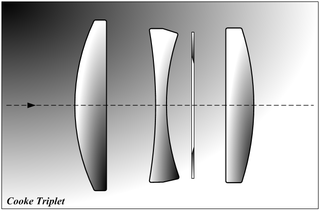 W
WThe Cooke triplet is a photographic lens designed and patented in 1893 by Dennis Taylor who was employed as chief engineer by T. Cooke & Sons of York. It was the first lens system that allowed elimination of most of the optical distortion or aberration at the outer edge of lenses.
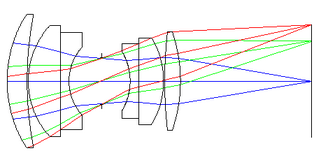 W
WThe double Gauss lens is a compound lens used mostly in camera lenses that reduces optical aberrations over a large focal plane.
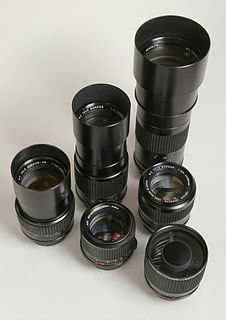 W
WRokkor was a brand name used for all Chiyoda Kōgaku Seikō and later Minolta lenses between 1940 and 1980, including a few, which were marketed and sold by other companies like Leica. The name was derived from the name of Rokkō (六甲山), a 932 m high mountain, which could be seen from the company's glass-making and optics factory at Mukogawa near Osaka, Japan. The company's founder Kazuo Tashima wanted the name to symbolize the high quality in optics.
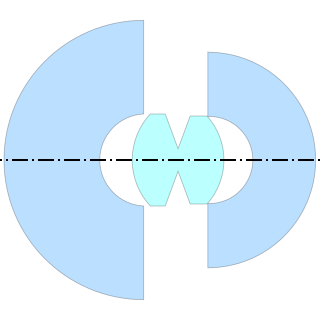 W
WThe Zeiss Hologon is an ultra wide-angle f=15mm f/8 triplet lens, providing a 110° angle of view for 35mm format cameras. The Hologon was originally fitted to a dedicated camera, the Zeiss Ikon Contarex Hologon in the late 1960s; as sales of that camera were poor and the Zeiss Ikon company itself was going bankrupt, an additional 225 lenses were made in Leica M mount and released for sale in 1972 as the only Zeiss-branded lenses for Leica rangefinders until the ZM line was released in 2005. The Hologon name was revived in 1994 for a recomputed f=16mm f/8 lens fitted to the Contax G series of rangefinder cameras.
 W
WThe Rodenstock Imagon is an achromat doublet photographic lens design uncorrected for spherical aberration used together with diffusion discs called sieve aperture. The lens is one of the classic professional soft-focus "portrait lenses".
 W
WYashica was a Japanese manufacturer of cameras, originally active from 1949 until 2005 when its then-owner, Kyocera, ceased production.
 W
WLight is an American digital photography company that has developed a multi-lens and multi-sensor camera designed for embedding in smartphones and mobile devices. The company's first product, the L16, is a standalone version with 16 camera modules. It plans to eventually provide mobile devices with higher-quality photo capabilities and true optical zoom.
 W
WThe Minolta CLE is a TTL-metering automatic exposure aperture-priority 35 mm rangefinder camera using Leica M lenses, introduced by Minolta in 1980.
 W
WA pancake lens is colloquial term for a flat, thin lens, generally a normal or slightly wide prime lens for a camera.
 W
WThe Zeiss Planar is a photographic lens designed by Paul Rudolph at Carl Zeiss in 1896. Rudolph's original was a six-element symmetrical design.
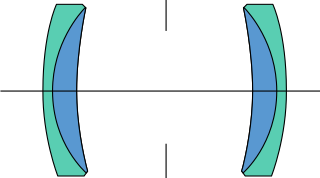 W
WThe Rapid Rectilinear also named Aplanat is a famous photographic lens design.
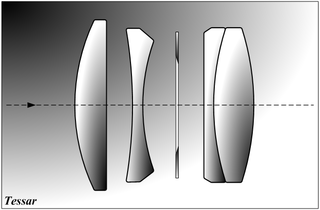 W
WThe Tessar is a photographic lens design conceived by the German physicist Paul Rudolph in 1902 while he worked at the Zeiss optical company and patented by Zeiss in Germany; the lens type is usually known as the Zeiss Tessar.
 W
WThe Tessar is a photographic lens design conceived by the German physicist Paul Rudolph in 1902 while he worked at the Zeiss optical company and patented by Zeiss in Germany; the lens type is usually known as the Zeiss Tessar.
 W
WThe Tessar is a photographic lens design conceived by the German physicist Paul Rudolph in 1902 while he worked at the Zeiss optical company and patented by Zeiss in Germany; the lens type is usually known as the Zeiss Tessar.
 W
WThe Tessar is a photographic lens design conceived by the German physicist Paul Rudolph in 1902 while he worked at the Zeiss optical company and patented by Zeiss in Germany; the lens type is usually known as the Zeiss Tessar.
 W
WThe Tessar is a photographic lens design conceived by the German physicist Paul Rudolph in 1902 while he worked at the Zeiss optical company and patented by Zeiss in Germany; the lens type is usually known as the Zeiss Tessar.
 W
WThe Rodenstock Imagon is an achromat doublet photographic lens design uncorrected for spherical aberration used together with diffusion discs called sieve aperture. The lens is one of the classic professional soft-focus "portrait lenses".
 W
WRokkor was a brand name used for all Chiyoda Kōgaku Seikō and later Minolta lenses between 1940 and 1980, including a few, which were marketed and sold by other companies like Leica. The name was derived from the name of Rokkō (六甲山), a 932 m high mountain, which could be seen from the company's glass-making and optics factory at Mukogawa near Osaka, Japan. The company's founder Kazuo Tashima wanted the name to symbolize the high quality in optics.
 W
WRokkor was a brand name used for all Chiyoda Kōgaku Seikō and later Minolta lenses between 1940 and 1980, including a few, which were marketed and sold by other companies like Leica. The name was derived from the name of Rokkō (六甲山), a 932 m high mountain, which could be seen from the company's glass-making and optics factory at Mukogawa near Osaka, Japan. The company's founder Kazuo Tashima wanted the name to symbolize the high quality in optics.
 W
WRokkor was a brand name used for all Chiyoda Kōgaku Seikō and later Minolta lenses between 1940 and 1980, including a few, which were marketed and sold by other companies like Leica. The name was derived from the name of Rokkō (六甲山), a 932 m high mountain, which could be seen from the company's glass-making and optics factory at Mukogawa near Osaka, Japan. The company's founder Kazuo Tashima wanted the name to symbolize the high quality in optics.
 W
WRokkor was a brand name used for all Chiyoda Kōgaku Seikō and later Minolta lenses between 1940 and 1980, including a few, which were marketed and sold by other companies like Leica. The name was derived from the name of Rokkō (六甲山), a 932 m high mountain, which could be seen from the company's glass-making and optics factory at Mukogawa near Osaka, Japan. The company's founder Kazuo Tashima wanted the name to symbolize the high quality in optics.
 W
WRokkor was a brand name used for all Chiyoda Kōgaku Seikō and later Minolta lenses between 1940 and 1980, including a few, which were marketed and sold by other companies like Leica. The name was derived from the name of Rokkō (六甲山), a 932 m high mountain, which could be seen from the company's glass-making and optics factory at Mukogawa near Osaka, Japan. The company's founder Kazuo Tashima wanted the name to symbolize the high quality in optics.
 W
WRokkor was a brand name used for all Chiyoda Kōgaku Seikō and later Minolta lenses between 1940 and 1980, including a few, which were marketed and sold by other companies like Leica. The name was derived from the name of Rokkō (六甲山), a 932 m high mountain, which could be seen from the company's glass-making and optics factory at Mukogawa near Osaka, Japan. The company's founder Kazuo Tashima wanted the name to symbolize the high quality in optics.
 W
WRokkor was a brand name used for all Chiyoda Kōgaku Seikō and later Minolta lenses between 1940 and 1980, including a few, which were marketed and sold by other companies like Leica. The name was derived from the name of Rokkō (六甲山), a 932 m high mountain, which could be seen from the company's glass-making and optics factory at Mukogawa near Osaka, Japan. The company's founder Kazuo Tashima wanted the name to symbolize the high quality in optics.
 W
WRokkor was a brand name used for all Chiyoda Kōgaku Seikō and later Minolta lenses between 1940 and 1980, including a few, which were marketed and sold by other companies like Leica. The name was derived from the name of Rokkō (六甲山), a 932 m high mountain, which could be seen from the company's glass-making and optics factory at Mukogawa near Osaka, Japan. The company's founder Kazuo Tashima wanted the name to symbolize the high quality in optics.
 W
WRokkor was a brand name used for all Chiyoda Kōgaku Seikō and later Minolta lenses between 1940 and 1980, including a few, which were marketed and sold by other companies like Leica. The name was derived from the name of Rokkō (六甲山), a 932 m high mountain, which could be seen from the company's glass-making and optics factory at Mukogawa near Osaka, Japan. The company's founder Kazuo Tashima wanted the name to symbolize the high quality in optics.
 W
WRokkor was a brand name used for all Chiyoda Kōgaku Seikō and later Minolta lenses between 1940 and 1980, including a few, which were marketed and sold by other companies like Leica. The name was derived from the name of Rokkō (六甲山), a 932 m high mountain, which could be seen from the company's glass-making and optics factory at Mukogawa near Osaka, Japan. The company's founder Kazuo Tashima wanted the name to symbolize the high quality in optics.
 W
WRokkor was a brand name used for all Chiyoda Kōgaku Seikō and later Minolta lenses between 1940 and 1980, including a few, which were marketed and sold by other companies like Leica. The name was derived from the name of Rokkō (六甲山), a 932 m high mountain, which could be seen from the company's glass-making and optics factory at Mukogawa near Osaka, Japan. The company's founder Kazuo Tashima wanted the name to symbolize the high quality in optics.
 W
WRokkor was a brand name used for all Chiyoda Kōgaku Seikō and later Minolta lenses between 1940 and 1980, including a few, which were marketed and sold by other companies like Leica. The name was derived from the name of Rokkō (六甲山), a 932 m high mountain, which could be seen from the company's glass-making and optics factory at Mukogawa near Osaka, Japan. The company's founder Kazuo Tashima wanted the name to symbolize the high quality in optics.
 W
WThe double Gauss lens is a compound lens used mostly in camera lenses that reduces optical aberrations over a large focal plane.
 W
WCarl Zeiss AG, branded as ZEISS, is a German manufacturer of optical systems and optoelectronics, founded in Jena, Germany in 1846 by optician Carl Zeiss. Together with Ernst Abbe and Otto Schott he laid the foundation for today's multi-national company. The current company emerged from a reunification of Carl Zeiss companies in East and West Germany with a consolidation phase in the 1990s. ZEISS is active in four business segments with approximately equal revenue, Industrial Quality and Research, Medical Technology, Consumer Markets and Semiconductor Manufacturing Technology in almost 50 countries, has 30 production sites and around 25 development sites worldwide.
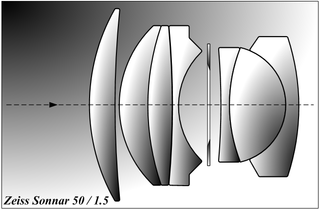 W
WThe Zeiss Sonnar is a photographic lens originally designed by Dr. Ludwig Bertele in 1929 and patented by Zeiss Ikon. It was notable for its relatively light weight, simple design and fast aperture.
 W
WThe Tessar is a photographic lens design conceived by the German physicist Paul Rudolph in 1902 while he worked at the Zeiss optical company and patented by Zeiss in Germany; the lens type is usually known as the Zeiss Tessar.
 W
WCarl Zeiss AG, branded as ZEISS, is a German manufacturer of optical systems and optoelectronics, founded in Jena, Germany in 1846 by optician Carl Zeiss. Together with Ernst Abbe and Otto Schott he laid the foundation for today's multi-national company. The current company emerged from a reunification of Carl Zeiss companies in East and West Germany with a consolidation phase in the 1990s. ZEISS is active in four business segments with approximately equal revenue, Industrial Quality and Research, Medical Technology, Consumer Markets and Semiconductor Manufacturing Technology in almost 50 countries, has 30 production sites and around 25 development sites worldwide.